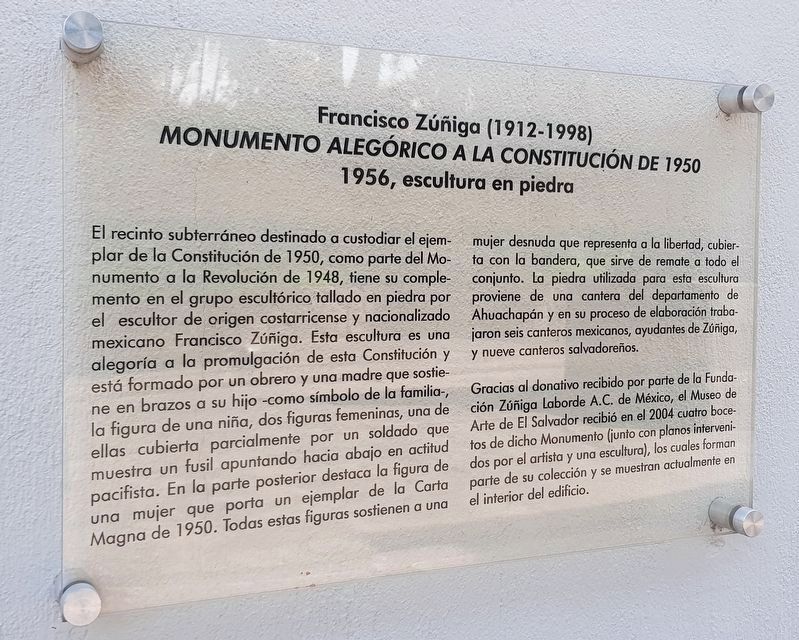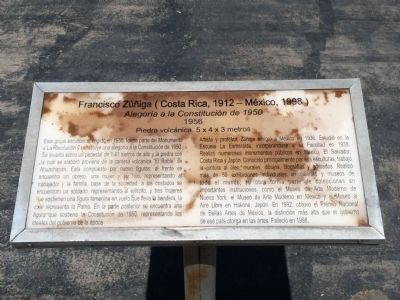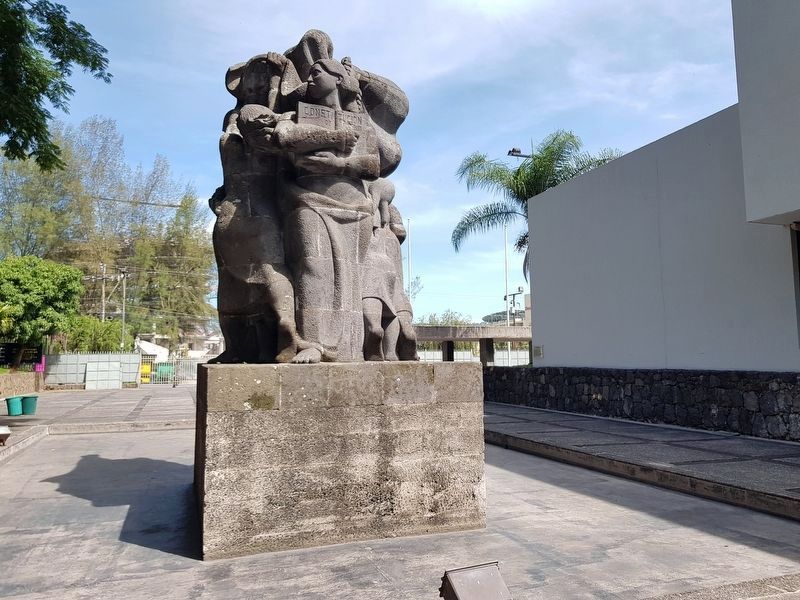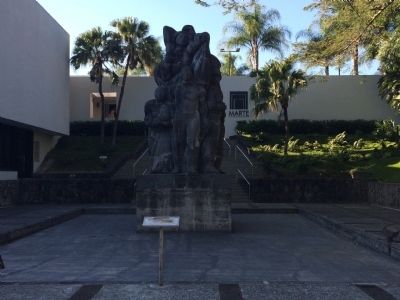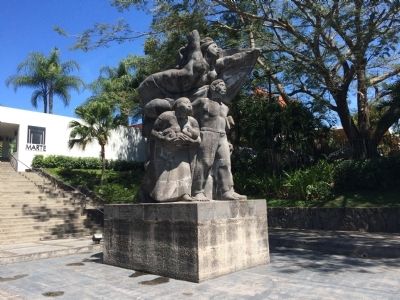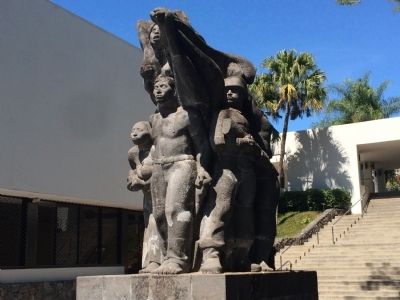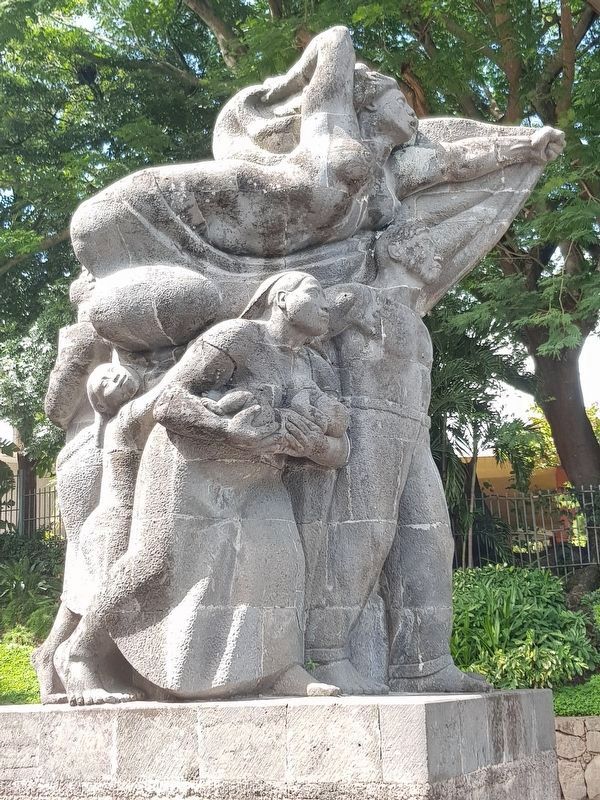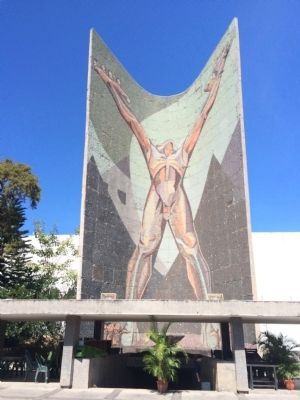San Salvador, El Salvador — Central America (West Coast)
Allegory to the Constitution of 1950
Alegoría a la Constitución de 1950
Francisco Zúniga (1912-1998)
1956, escultura en piedra
El recinto subterráneo destinado a custodiar el ejemplar de la Constitución de 1950, como parte del Monumento a la Revolución de 1948, tiene su complemento en el grupo escultórico tallado en piedra por el escultor de origen costarricense y nacionalizado mexicano Francisco Zúñiga. Esta escultura es una alegoría a la promulgación de esta Constitución y está formado por un obrero y una madre que sostiene en brazos a su hijo - como símbolo de la familia - la figura de una niña, dos figuras femeninas, una de ellas cubierta parcialmente por un soldado que muestra un fusil apuntando hacia abajo en actitud pacifista. En la parte posterior destaca la figura de una mujer que porta un ejemplar de la Carta Magna de 1950. Todas estas figuras sostienen a una mujer desnuda que representa a la libertad, cubierta con la bandera, que sirve de remate a todo el conjunto. La piedra utilizada para esta escultura proviene de una cantera del departamento de Ahuachapán y en su proceso de elaboración trabajaron seis canteros mexicanos, ayudantes de Zúñiga, y nueve canteros salvadoreños.
Gracias al donativo recibido por parte de la Fundación Zúñiga Laborde A.C. de México, el Museo de Arte de El Salvador recibió en el 2004 cuatro bocetos de dicho Monumento (junto con planos intervenidos por el artista y una escultura), los cuales forman parte de su colección y se muestran actualmente en el interior del edificio.
Allegory to the Constitution of 1950
Francisco Zúñiga (1912-1998)
1956, stone sculpture
The underground enclosure intended to guard an original of the Constitution of 1950, as part of the Monument to the Revolution of 1948, has its complement in the sculptural group carved in stone by the Costa Rican, later naturalized Mexican, sculptor Francisco Zúñiga. This sculpture is an allegory to the promulgation of this Constitution and is formed by the figures of a worker and a mother, who holds her son in her arms - as a family symbol - the figure of a girl and two additional female figures, one of them partially covered by a soldier who holds a rifle pointing down in a pacifist attitude. On the reverse stands the figure of a woman who carries a copy of the 1950 Consitution. All these figures support a naked woman who represents freedom, covered with the flag, which serves to unite the entire sculpture. The stone used for this sculpture
comes from a quarry in the department of Ahuachapán and in its construction worked six Mexican stonecutters, Zúñiga’s assistants, and nine additional Salvadoran stonecutters.
Thanks to the donation received from the Zúñiga Laborde Foundation of Mexico, the El Salvador Museum of Art received in 2004 four sketches of this monument (together with plans by the artist and another sculptor), which are part of its collection and are currently displayed inside the building.
Erected 1956.
Topics. This historical marker is listed in this topic list: Arts, Letters, Music. A significant historical year for this entry is 1956.
Location. 13° 41.562′ N, 89° 14.498′ W. Marker is in San Salvador. Marker is on Calle Circunvalacion, on the right when traveling west. The marker is on the grounds of the Museum of Modern Arte (MARTE) of San Salvador in the San Benito neighborhood. Touch for map. Marker is in this post office area: San Salvador 01101, El Salvador. Touch for directions.
Other nearby markers. At least 8 other markers are within walking distance of this marker. Monument to the Revolution of 1948 (a few steps from this marker); Valero Lecha (within shouting distance of this marker); Claudia Lars (within shouting distance of this marker); Agustín Barrios (within shouting distance of this marker); Pancho Lara (within shouting distance of this marker);
Salarrué (within shouting distance of this marker); General Francisco de Paula Santander (approx. 0.4 kilometers away); Inca Garcilaso de la Vega (approx. half a kilometer away). Touch for a list and map of all markers in San Salvador.
Additional commentary.
1. Text of the previous Allegory to the Constitution of 1950 Marker
Alegoría a la Constitución de 1950
1956
Piedra volcánica, 5 x 4 x 3 metros
Este grupo escultórico erigido en 1956, forma parte del Monumento a La Revolución y constituye una alegoría a la Constitución de 1950. Se levanta sobre un pedestal de 1.41 metros de alto y la piedra con la cual se elaboró proviene de la cantera volcánica “El Roble” de Ahuachapán. Está compuesto por nueve figuras: al frente se encuentra un obrero, una mujer y su hijo, representando al trabajador y la familia, base de la sociedad; a los costados se encuentran un soldado, representando al ejército, y tres mujeres que sostienen una figura femenina en vuelo que lleva la bandera, la cual representa la Patria. En la parte posterior se encuentra
una figura que sostiene la Constitución de 1950, representando los ideales del gobierno de la época.
Artista y profesor, Zúñiga emigro a México en 1936. Estudio en la Escuela La Esmeralda, incorporándose a su Facultad en 1938. Realizo numerosos monumentos públicos en México, El Salvador, Costa Rica y Japón. Conocido principalmente por sus esculturas, trabajo la pintura al óleo, murales, dibujos, litografías y grabados. Realizo más de 50 exhibiciones individuales en galerías y museos de todo el mundo; su obra forma parte de colecciones en importantes instituciones, como el Museo de Arte Moderno de Nueva York, el Museo de Arte Moderno en México y el Museo al Aire Libre en Hakone, Japón. En 1992, obtuvo el Premio Nacional de Bellas Artes de México, la distinción más alta que el gobierno de ese país otorga en las artes. Falleció en 1998.
Francisco Zúñiga (Costa Rica, 1912 - Mexico, 1998)
Allegory to the Constitution of 1950
1956
Volcanic stone, 5 x 4 x 3 meters
This sculpture was erected in 1956 and is part of the Monument to the Revolution as an allegory to the Constitution of 1950. It stands on a pedestal of 1.41 meters high and the stone comes from the volcanic quarry "El Roble" in Ahuachapan. This work consists of nine figures: in the front is a worker, a woman and her son, representing the worker and the family which are the foundation of society; the figures on the side include a soldier, representing the army, and three women holding a feminine figure in flight carrying the flag, which represents the country. On the back is a figure holding the Constitution of 1950, representing the ideals of the government of the time.
Artist and professor Zuñiga emigrated to Mexico in 1936. He studied at the La Esmeralda School, becoming part of its faculty in 1938. He made numerous public monuments in Mexico, El Salvador, Costa Rica and Japan. He is known primarily for his sculptures, oil paintings, murals, drawings, lithographs and engravings. He performed over 50 solo exhibitions in galleries and museums around the world; his work is in the collections of major institutions such as the Museum of Modern Art in New York City, the Museum of Modern Art in Mexico and the Open Air Museum in Hakone, Japan. In 1992, he won the National Fine Arts Prize in Mexico, the highest distinction that the government of that country grants in the arts. He died in 1998.
— Submitted August 13, 2019, by J. Makali Bruton of Accra, Ghana.
Credits. This page was last revised on August 14, 2019. It was originally submitted on February 15, 2015, by J. Makali Bruton of Accra, Ghana. This page has been viewed 544 times since then and 40 times this year. Photos: 1. submitted on August 13, 2019, by J. Makali Bruton of Accra, Ghana. 2. submitted on February 15, 2015, by J. Makali Bruton of Accra, Ghana. 3. submitted on August 13, 2019, by J. Makali Bruton of Accra, Ghana. 4, 5, 6. submitted on February 15, 2015, by J. Makali Bruton of Accra, Ghana. 7. submitted on August 13, 2019, by J. Makali Bruton of Accra, Ghana. 8. submitted on February 15, 2015, by J. Makali Bruton of Accra, Ghana. • Andrew Ruppenstein was the editor who published this page.
